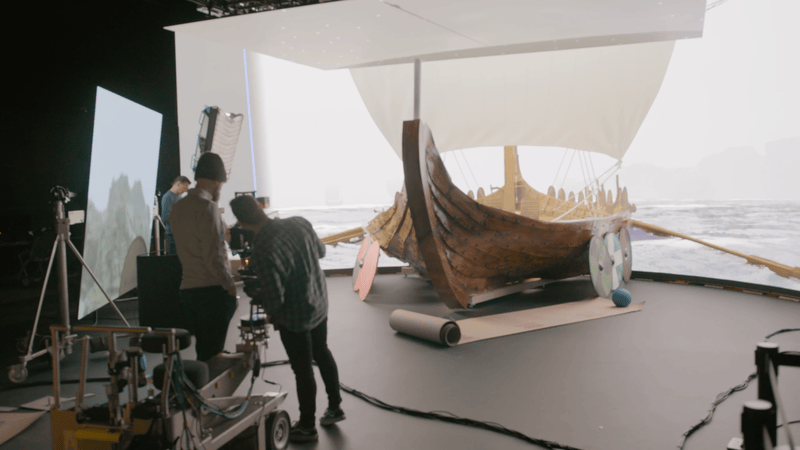From Green Screens to LED Dreams: The Origins of Virtual Production
Virtual production has completely changed how we create visual stories. Whether you’re shooting a sci-fi epic or a lifestyle campaign, it blends real-time technology with traditional filmmaking to create something totally new and incredibly powerful.
But where did it all begin? How did we go from neon green backdrops to fully immersive LED environments? Let’s break down the origins of virtual production, how Unreal Engine became the leading creative tool, and how we arrived at the game-changing workflows used today.
Behind the scenes at Golden Hour Virtual Production Studio
What Is Virtual Production?
At its core, virtual production is a way of blending live-action footage with real-time computer-generated environments. It allows filmmakers to see and capture final (or near-final) visuals in-camera without relying entirely on post-production.
This includes technologies like:
LED volumes (large curved LED screens that display virtual backgrounds),
Camera tracking systems (like OptiTrack),
Real-time rendering engines (like Unreal Engine),
And tools for motion capture, previs, and remote collaboration.
It has become one of the most exciting evolutions in modern filmmaking and is changing the way content is made across the board.
Where It Started: Early Innovations in Filmmaking
Virtual production didn’t arrive overnight. It’s the result of years of experimentation, breakthroughs in technology, and a growing need for more flexible, efficient, and immersive production methods. The roots of virtual production go back to the early days of VFX and previsualization.
Before we had real-time environments on LED walls, filmmakers were already using digital tools to help plan and execute complex scenes. Previsualization (or "previs") became common in the 1990s and early 2000s, allowing directors to block scenes, test camera angles, and visualize VFX shots before filming began.
Studios like ILM and Weta Digital pioneered the integration of CGI with live-action. They developed digital doubles, complex motion capture rigs, and fully virtual sets—many of which served as the earliest forms of virtual production, even if they didn’t happen in real time.
Image from Star Wars: Episode I - The Phantom Menace (1999)
George Lucas and Star Wars: Episode I - The Phantom Menace (1999)
One of the first major attempts at combining digital environments with live-action was during the making of The Phantom Menace. The film pushed the limits of greenscreen compositing, virtual backgrounds, and early CGI character integration. Jar Jar Binks may have been divisive, but he was one of the first fully digital characters to interact with physical actors in such a complex way.
Image from The Lord of the Rings (2001)
Peter Jackson and The Lord of the Rings (2001–2003)
The use of motion capture with actor Andy Serkis as Gollum introduced a new level of realism. These films relied on sophisticated previs and digital compositing techniques, allowing actors to perform in scenes where entire environments or characters were added later. While still relying on traditional post-production pipelines, these films laid the groundwork for mixing digital worlds with live performances.
Image from Avatar (2009)
James Cameron and Avatar (2009): A Turning Point
The real game-changer was Avatar. James Cameron developed a proprietary virtual camera system that let him direct actors in motion capture suits and simultaneously view their performances within a CG environment. He was, in essence, shooting inside a video game engine—years before real-time rendering became the standard.
This gave directors unprecedented control over framing, lighting, and performance inside a fully digital world. It also allowed for faster iteration, more intuitive directing, and an early glimpse of what real-time, in-camera visual storytelling could look like.
As filmmakers experimented with these tools, the lines between game engines and film pipelines began to blur. Early adopters started looking at real-time rendering tools as a way to speed up the production process, create more accurate on-set previews, and bring virtual worlds to life with less lag between idea and execution.
The LED Volume Breakthrough
Green screens were a massive step forward when they first became mainstream. Suddenly, you could film in front of a blank screen and composite in any background you wanted. But green screens came with a catch. Actors had to perform in front of nothing. Lighting didn’t match the virtual world. Post-production became heavier, slower, and more expensive. Filmmakers had to imagine what the final shot would look like. Directors would point at a green backdrop and tell the talent, “Pretend there’s a giant spaceship there.” Not exactly immersive…
The turning point came with The Mandalorian (2019). Instead of using green screens, the production team used massive curved LED screens that displayed virtual environments in real time. These screens were powered by Unreal Engine, a tool originally built for video games.
This allowed for:
Real reflections and lighting from the virtual environment,
Immediate feedback for directors and actors,
And drastically reduced time in post.
It changed the industry overnight.
The Future of Virtual Production
We’re still just scratching the surface. As tools evolve and real-time technology gets faster and more affordable, virtual production will only grow more versatile.
Expect to see more AI-generated environments, volumetric capture, cloud-based workflows, and even consumer-grade VP tools. It’s no longer just about sci-fi films or big-budget shows. This is the new normal for storytelling. Virtual production didn’t come out of nowhere. It’s the result of decades of innovation, game engine breakthroughs, and creative problem-solving from filmmakers who refused to accept the limits of traditional production.
And now? It’s your turn.
Whether you're imagining another galaxy or just need the perfect golden hour shot indoors, we’re ready to help you make it real.




